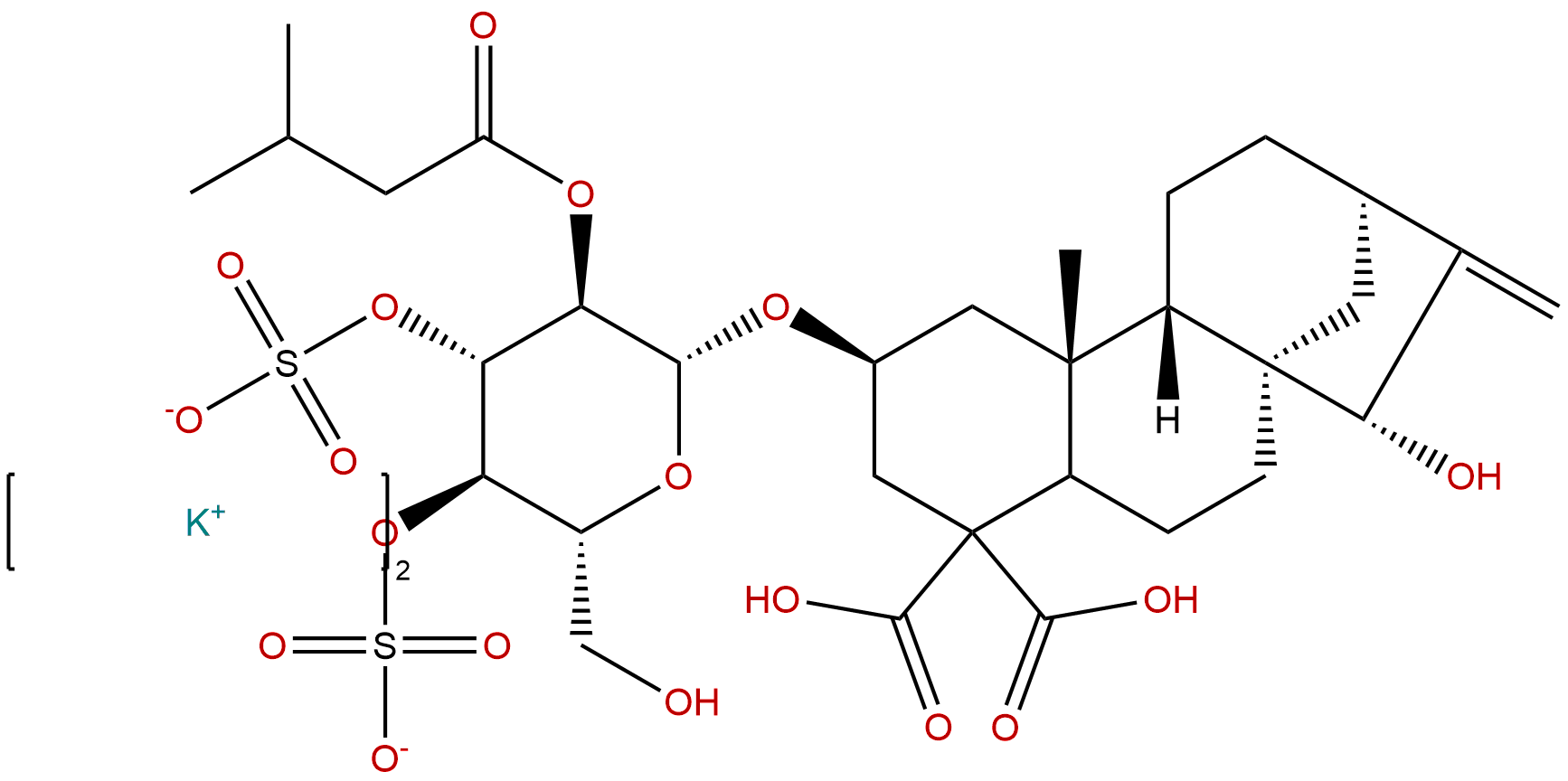
Carboxyatractyloside Potassium SaltCAS No.:77228-71-8
|
||||||||||
 |
|
|
||||||||

| Catalogue No.: | BP1660 |
| Formula: | C31H46O18S2 |
| Mol Weight: | 770.811 |
Product name: Carboxyatractyloside Potassium Salt
Synonym name: Carboxyatractyloside dipotassium salt; CAT dipotassium salt; Potassium carboxyatractyloside
Catalogue No.: BP1660
Cas No.: 77228-71-8
Formula: C31H44K2O18S2
Mol Weight: 846.992
Botanical Source: Xanthium sibiricum
Physical Description: Powder
Type of Compound: Diterpenoids
Purity: 95%~99%
Analysis Method: HPLC-DAD or/and HPLC-ELSD
Identification Method: Mass, NMR
Packing: Brown vial or HDPE plastic bottle
The product could be supplied from milligrams to grams. Inquire for bulk scale.
We provide solution to improve the water-solubility of compounds, thereby facilitating the variety of activity tests and clinic uses.
For Reference Standard and R&D, Not for Human Use Directly.
Description:
Carboxyatractyloside poisoning causes multiple organ dysfunction and can be fatal, the signs of a poor prognosis including coagulation abnormalities, hyponatraemia, marked hypoglycaemia, icterus and hepatic and renal failure, without antidote. Carboxyatractyloside can induce permeability transition, and that ageing induced mitochondrial DNA disruption and release of cytochrome c; it induces the inhibitory effect of tamoxifen on nonspecific membrane permeability.
References:
Life Sci. 2011 Apr 11;88(15-16):681-7.
Protective action of tamoxifen on carboxyatractyloside-induced mitochondrial permeability transition.
Mitochondrial permeability transition is established after massive Ca(2+) accumulation inside the matrix, in addition to an inducer. The closure of the pore can be accomplished by adenosine diphosphate and the immunosuppressant cyclosporin A. Recently, the estrogen antagonist, tamoxifen, has been introduced as an inhibitor of the opening of the permeability transition pore. However, the mechanism by which this drug inhibits pore opening is still under discussion. This work was performed with the purpose of establishing the membrane system involved in tamoxifen-induced pore closure. For this purpose, permeability transition was induced after the addition of Carboxyatractyloside, which is a specific reagent that interacts with the adenine nucleotide translocase.
METHODS AND RESULTS:
Permeability transition was assessed by analyzing matrix Ca(2+) release, transmembrane electric gradient, and mitochondrial swelling in aged, as well as in freshly prepared mitochondria. Also, cytochrome c content was analyzed in membrane mitochondria as well as in the supernatant. In freshly prepared mitochondria, tamoxifen, at the concentration of 10 μM, totally inhibited nonspecific membrane permeability induced by 1 μM Carboxyatractyloside. In addition, tamoxifen inhibited non-specific permeability in aged mitochondria and diminished membrane fluidity.
CONCLUSIONS:
Plausibly, the inhibitory effect of tamoxifen on nonspecific membrane permeability, as induced by Carboxyatractyloside, should be ascribed to a diminution, of membrane fluidity by this drug.
Radiat Res. 2009 Nov;172(5):575-83.
Cyclosporin A inhibits UV-radiation-induced membrane damage but is unable to inhibit carboxyatractyloside-induced permeability transition.
This work was undertaken to gain further information on the chemical characteristics of the membrane entity involved in the formation of the nonspecific pore.
METHODS AND RESULTS:
Mitochondria were subjected to oxidative stress by exposure to UV radiation. The results indicate that ultraviolet C radiation induces structural modifications in the adenine nucleotide translocase that lead to membrane permeability transition. Membrane leakage was assessed by measuring mitochondrial Ca2+ transport, the transmembrane electric gradient, and mitochondrial swelling. UV-irradiated mitochondria were unable to retain matrix Ca2+ or to maintain a high level of membrane potential when Ca2+ was added; furthermore, UV-irradiated mitochondria underwent large amplitude swelling. Release of cytochrome c and formation of malondialdehyde, owing to lipid peroxidation, were also seen. Structural modifications of the translocase were revealed by an increase in the binding of the fluorescent probe eosin-5-maleimide to thiol residues of the ADP/ATP carrier.
CONCLUSIONS:
These modifications, taken together with findings indicating that cyclosporin resulted unable to inhibit Carboxyatractyloside-induced permeability transition, prompted us to conclude that the translocase could constitute the nonspecific pore or at least be an important modulator of it.
Ann Trop Paediatr. 2005 Jun;25(2):125-34.
Carboxyatractyloside poisoning in humans.
Cocklebur (Xanthium strumarium) is an herbaceous annual plant with worldwide distribution. The seeds contain the glycoside Carboxyatractyloside, which is highly toxic to animals. We describe nine cases of Carboxyatractyloside poisoning in humans which, to our knowledge, has not previously been reported. The clinical, laboratory and histopathological findings and our therapeutic approach are also discussed.
METHODS AND RESULTS:
The patients presented with acute onset abdominal pain, nausea and vomiting, drowsiness, palpitations, sweating and dyspnoea. Three of them developed convulsions followed by loss of consciousness and death. Laboratory findings showed raised liver enzymes, indicating severe hepatocellular damage. BUN and creatinine levels were raised, especially in the fatal cases who also displayed findings of consumption coagulopathy. CPK-MB values indicative of myocardial injury were also raised, especially in the fatal cases. Three of the patients died within 48 hours of ingesting Carboxyatractyloside. Post-mortem histopathology of the liver confirmed centrilobular hepatic necrosis and renal proximal tubular necrosis, secondary changes owing to increased permeability and microvascular haemorrhage in the cerebrum and cerebellum, and leucocytic infiltrates in the muscles and various organs including pancreas, lungs and myocardium.
CONCLUSIONS:
Carboxyatractyloside poisoning causes multiple organ dysfunction and can be fatal. Coagulation abnormalities, hyponatraemia, marked hypoglycaemia, icterus and hepatic and renal failure are signs of a poor prognosis. No antidote is available and supportive therapy is the mainstay of treatment.